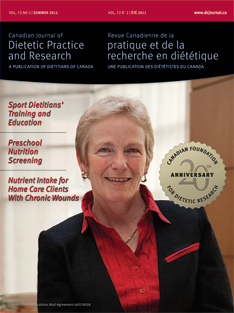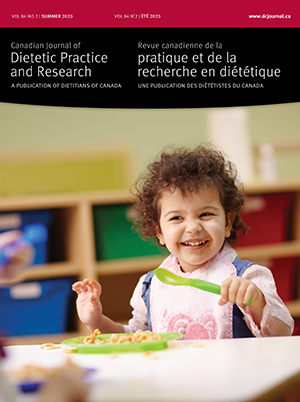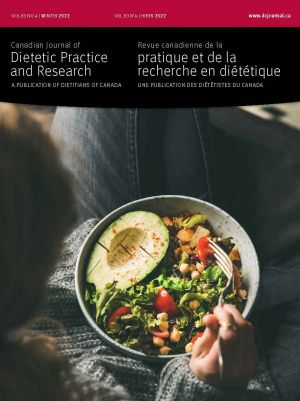Volume 72 • Number 2 • July 2011
Chair’s Message
Editor’s Message
Letter to the Editor
Research
Purpose: Pregnant women’s diets should be monitored to ensure adequacy, but few studies have assessed the validity of dietary assessment tools among pregnant women. We examined the relative validity of a self-administered, semiquantitative food frequency questionnaire (FFQ) adapted for use in the International Trial of Antioxidants in the Prevention of Preeclampsia for assessing usual diet during pregnancy. Methods: A subsample (n=107) was recruited for the FFQ validation study, and provided three days of nonconsecutive threeday food records (3D-FRs) following completion of the FFQ. Results: Mean ± standard deviation (median) energy intakes (kcal/kJ) from the FFQ and mean of 3D-FRs were 1963 ± 610 (1860)/8219 ± 2554 (7787) and 2320 ± 607 (2354)/9713 ± 2541 (9856), respectively. Spearman correlation coefficients between unadjusted FFQ and 3D-FRs nutrients were positive (rS ranged from 0.17 for iron to 0.49 for folate) and were generally statistically significant (0.05<p<0.01). Most energy-adjusted correlations were less robust. Cross-classification of energy and 24 nutrients from the FFQ and means of the 3D-FRs placed 35% of them into identical quartiles and 75% into identical and contiguous quartiles; only 6% were frankly misclassified. Bland– Altman plots showed acceptable agreement between the two instruments. Conclusions: These results suggest that the FFQ is a relatively valid instrument for determining usual diet in pregnant women.
Attitudes et habitudes de Canadiens relativement: à la planification des repas et à la cuisine maiso
But: Décrire les attitudes et habitudes de Canadiens relativement à la planification et à la préparation des repas à domicile dans le but de saisir les motivations à exploiter lors de promotion de la cuisine maison. Méthodes: Un sondage électronique composé de 39 questions à choix multiples a été affiché sur le site Web des Diététistes du Canada entre le 16 novembre et le 22 décembre 2006. Les énoncés analysés abordent la perception des bénéfices associés à la cuisine maison, les obstacles qui empêchent les gens de cuisiner, le temps de préparation et la planification des repas, l'apprentissage de la cuisine et les sources d'idées de recettes. Résultats: Au total, 4080 personnes ont rempli le questionnaire. Bien qu'ils croient que la cuisine maison puisse améliorer la qualité de l'alimentation et les comportements alimentaires, les répondants rencontrent plusieurs obstacles au quotidien en ce qui concerne la préparation des aliments. Parmi ceux-ci figure le manque de temps, d’énergie, d'idées et de planification. Conclusions: Cette étude souligne la pertinence d’élaborer des stratégies non seulement pour éduquer les consommateurs sur les bénéfices de la cuisine maison, mais également pour leur transmettre de l'information pratique afin de les aider à surmonter les obstacles qui limitent la préparation des aliments au quotidien.
Purpose: The dietary nutrients iron and long-chain polyunsaturated fatty acids are believed to play an important role in early brain development. We investigated the relationship between pregnant women's iron and docosahexaenoic acid (DHA) status and their infants’ cognitive performance at age six months. Methods: Blood iron and DHA status were analyzed in pregnant women at 28 to 32 weeks of gestation. The women's dietary habits, sociodemographic background, and cognitive performance were assessed using questionnaires. At age six months, infants’ blood hemoglobin was analyzed, feeding practices assessed, and weight, length, and head circumference recorded. Each infant's cognitive performance was assessed using the Brunet–Lézine Scale of Psychomotor Development of Early Childhood and the Bayley Scales of Infant Development. Sixty-three mother–infant dyads completed the study. Results: During pregnancy, 9.5% of pregnant women were anemic, 34.9% had low iron stores, and 3.2% suffered from iron deficiency anemia. The DHA represented 4.36% and 2.15% in erythrocyte and plasma total fatty acids, respectively. These levels were considered adequate. No significant relationship was observed between gestational iron or DHA status and infants’ cognitive performance. Conclusions: In this small group of infants born to mothers with relatively good feeding practices and a privileged socioeconomic background, cognitive testing with the instruments above was not associated with maternal iron and DHA levels at age six months.
Perspectives in Practice
To assess relationships among food intake, anthropometrics, and wound severity, we studied 31 home care clients with pressure ulcers (PUs) or venous stasis ulcers (VSUs). Anthropometric variables (weight, height, waist circumference [WC]) were measured according to standard methodologies. Risk for PU development was assessed using the Braden Pressure Ulcer Risk Assessment score and wound severity according to the National Pressure Ulcer Advisory Panel. Three-day food records were analyzed to assess dietary adequacy. Adults with VSUs (65.8 ± 18.4 years) had a higher body mass index (48.1 vs. 25.9), WC (146.6 vs. 98.4 cm), and Braden score (20.2 vs. 17.5) than did those with PUs (67.8 ± 17.9 years) (p <0.05). Energy, protein, and zinc intake by diet alone did not meet estimated requirements in 41%, 32%, and 54.5% of clients, respectively. Intake by diet alone met the Estimated Average Requirement/ Adequate Intake for all nutrients except fibre, vitamin D, vitamin E, vitamin K, folate, calcium, magnesium, and potassium. Nutrient supplementation resolved this for all nutrients except fibre, vitamin K, and potassium. In multivariate analysis, increasing wound severity was associated with decreased intakes of vitamin A, vitamin K, magnesium, and protein (r2=0.90, p<0.001). Optimizing nutrient intake may be an important strategy to promote wound healing and decrease wound severity in home care clients with chronic wounds.
Factors that influence the menu planning process in Ontario long-term care (LTC) homes were studied, as were key informants’ perspectives on how this process could be improved to promote resident-centred menus. Key informants were interviewed by telephone to obtain qualitative data through standardized open-ended questions. The key informants (n=35) were randomly selected nutrition managers of Ontario LTC homes. Selected registered dietitians from the Ontario Long-Term Care Action Group also participated (n=5). Descriptive thematic analysis was completed on data provided. Three overarching themes emerged from the data as drivers in the menu planning process: resource limitations, Ontario Ministry of Health and Long-Term Care standards, and the accommodation of diverse and evolving preferences. Challenges involving resources include insufficient food labour and raw food funding, the workload involved with altering menus, and providing food items for special diets or preferences. In terms of ministry standards, participants reported barriers to complying with rotation and portion standards. Other common obstacles within LTC homes include accommodating personal preferences, cultural preferences, and therapeutic diets. Ontario LTC homes face numerous challenges in the planning of menus for residents, regardless of a home's size, location, or profit status. Suggestions are aimed at improving the menu planning process and providing high-quality, palatable, and culturally appropriate food in these homes so that menus are resident-centred.
We explored the effect of relocating to a personal care home (PCH) on older adults’ nutritional status and eating habits. Fourteen Caucasian older adults (F=57%) with a mean age of 83 years (standard deviation = 9.79) consented to participate. Anthropometric information (height, weight, bioelectrical impedance analysis), biochemical and clinical information (diagnoses, data from scales measuring risk or function), and dietary information (three-day plate waste analysis) were collected at time points A (two to three months after relocation) and B (six to seven months after relocation) through face-to-face interviews and medical chart reviews, and from nursing staff. At time B, cognitive function declined (z = -2.185, p<0.05) and the number of medications prescribed increased (z = -2.00, p<0.05). Levels of 25-hydroxyvitamin D were insufficient among 83% of participants at both time points. Mean serum albumin was 34.4 ± 7.2 g/L at time B, and the prevalence of potential nutritional risk increased from 57% to 77%. Dietary intake was inadequate at both time points. Nutritional risk became more prevalent at time B. Protein–energy malnutrition and other nutritional inadequacies may result if dietary intakes do not improve. Strategies to improve dietary intakes should be implemented within PCHs to reduce potential malnutrition.
Report
Purpose: Dual energy X-ray absorptiometry (DXA) and air displacement plethysmography (ADP) are commonly used to assess body composition. Accurate body fat measures are valuable in a variety of populations. Because DXA, the reference standard, is expensive and labour-intensive, determining whether these two methods are interchangeable is important. Methods: Forty-five female undergraduate students aged 21 to 33 with body mass indexes of 18.3 to 28.6 kg/m2 were recruited from the University of Guelph. Each participant underwent one full-body DXA scan and one ADP assessment, to determine total percent fat mass (%FM). Results: The Pearson's correlation between %FMDXA (27.1 ± 4.8) and %FMADP (26.1 ± 5.5) indicated good association (r=0.88, p<0.01). While Bland–Altman analysis revealed no systematic bias between the two methods (R2=0.07, p=0.08), large intraindividual variation occurred (95% confidence interval: -5.86% to 4.11%); this was related to height, weight, body-surface area, and lung volume. Conclusions: The two methods were significantly correlated. Mean %FM was not significantly different and no systematic bias between methods was observed. These findings indicate that ADP and DXA may be used interchangeably for determining %FM at the group level in healthy young women; a large intraindividual variation between the methods precludes interchangeability at the individual level.
Purpose: The study was undertaken to evaluate the education and training background of Canadian registered dietitians (RDs) practising in sport and exercise nutrition, as well as learning opportunities in the practice area. Methods: A secondary analysis of a 2009 Dietitians of Canada (DC) Sport Nutrition Network survey of members (n=70) was conducted to describe members’ educational background. Through the use of publicly available information, Canadian dietetic internship, undergraduate, and graduate sport nutrition educational opportunities were identified. Results: Most (72.9%) respondents indicated they had some type of formal education in sport nutrition; learning from undergraduate courses and conference sessions was cited most frequently. The majority (86.7%) of accredited universities offered undergraduate courses in sport/exercise nutrition. No DC-accredited internship program offered sport nutrition as a mandatory rotation, while 15.8% of graduate programs in Canada had faculty with research interests in the area. Among respondents, 91.4% felt sport nutrition education in Canada was inadequate; all expressed interest in participating in more formal learning experiences, and 97.1% were interested in a specialized credential. Conclusions: Canadian dietitians working in sport and exercise nutrition have diverse educational backgrounds and must direct their own learning. Improved career development pathways and more available formal education are desired and needed.
Purpose: An oncology nutrition referral priority rating system (NRPRS) was developed and evaluated as a tool to classify patients into nutrition risk categories and allocate reasonable wait times. Methods: A retrospective chart audit (n=112), patient focus groups (n=14), and a prospective chart audit (n=179) were conducted to refine the tool. Using the NRPRS, the dietitians assigned a priority rating from the information on the referral and then compared it with a second rating after the first visit. Education to referring staff was provided to improve the completeness of referrals. Results: Patients rated at highest nutrition risk (priorities 1 and 2 [P1 and P2]) had a rating similar to the dietitian's after the first visit (P1, 97%; P2, 84%). Incomplete referrals were assigned a P3 rating. This may explain the discrepancy in ratings for P3 referrals (64%). After education, essential information on the referral form increased by 26%. Conclusions: The NRPRS is an effective tool for prioritizing high-risk patients when referrals are completed fully. The next step is to validate the NRPRS now that computerized order entry is implemented in the cancer clinic.
Purpose: Identifying nutrition-related problems during the early years may provide an opportunity to enhance parents’ abilities to support healthy growth and development. The Nutrition Screening Tool for Every Preschooler (NutriSTEP®) is a validated, parent-administered questionnaire designed to identify preschool children at nutritional risk. Parents can complete NutriSTEP® in under five minutes. Parents’ and staff's views of NutriSTEP® implementation feasibility were assessed in two community health centres. Methods: Parents attending preschool immunization clinics were recruited. Parents, staff, and physicians were asked for their opinions on screening. Results: The 412 (34%) parent questionnaires completed indicated that parents found NutriSTEP® easy to complete and helpful for identifying areas of nutrition concern. Staff estimated screening distribution took one to three minutes. Clerks and nurses expressed concern about additional workload and demands on parents. Managers believed NutriSTEP® was easy to implement. Physicians considered nutrition screening of preschoolers important, and felt that health centres were the best location for screening. Conclusions: NutriSTEP® was relatively easy to implement in two community health clinics. While staff expressed concern about increased workload, parents found it easy to complete and helpful.










